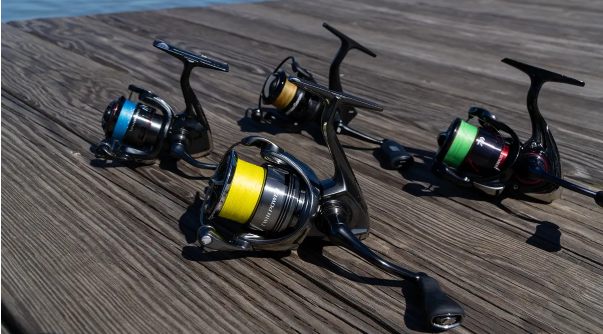
For the UK angler, standing on the misty riverside or rugged coastline or beside the sleepy canal, a perfect set of tackle must be at hand. They are the bridge between ability and success. However, for fishing beginners at least, many tend to confuse fishing reel and fishing rod. So, is there a competition between the two? Which is the most important? The truth, however, is interesting and much more complex. It is the knowledge of these two tools – their roles, plus their interworking – that changes an aspiring cast into a rewarding catch.
The Fishing Rod: Your Engine and Sensory Extension
Your fishing rod should be considered the engine and nervous system for a stand-alone fishing setup. It is the tool that you hold and work with physically, deciding the fishing power, finesse, and range.
- Casting: Casts are determined by rod length, action (where it bends), and power (how strongly it resists bending). A long, indeed flexible beach caster muscle the heavy leads out into the surf, while a short, stiff, almost rocket-like boat rod gives good vertical presentation for deep-sea species. A very light match rod can counterpoint a float with pinpoint accuracy on a Stillwater.
- Striking and Hooking: The rod transmits vibrations or bending to give the angler feedback of a fish’s nibble and set the hook effectively. A fast-action rod permits a very sharp, instantaneous hookset, whereas a slower-action one absorbs the fish’s struggles better and is well suited to fighting hard-fighting fishlike carp or pike, especially if there is the threat of snags.
- Playing the Fish: And maybe the most important role of the fishing rod. It absorbs shocks as the rod bends to soothe the powerful runs and shakes of a hooked fish. The rod’s back will disperse the pressure along the backbone and through action, saving the finer fishing line from breaking and wearing out the fish in the most efficient way possible. Choosing a rod that is under spotted for your target species is a brilliant way to make sure of very angry lost fish and frustration.
- Carry-ons: The fishing rod will dictate distance and presentation and thus the style of fishing, and target species, and it will gently give the bite detection and leverage needed to successfully progress into fighting the fish.
The Fishing Reel: Your Control Centre and Line Manager
The fishing reel is like a gearbox and control hub if the rod is the engine. It is responsible for depositing your line onto the spool during a cast and retrieving it back out. The drag of the reel becomes very important from the moment the fight is initiated.
- Line Storage and Retrieval: Line is stored on a spool and retrieved by means of an efficient and smooth retrieval mechanism; its efficiency and smoothness are all-important. A coarse fishing fixed-spool reel (or spinning, as the Americans call it) makes casting and line control among light tackle easy. In contrast, a multiplier reel puts power and line to good use for heavy sea fishing or big-predator work.
- Drag System: The drag system is this reel’s unsung hero. An efficient drag system, under tension, allows line to slip off the spool in the controlled manner of a powerful run from the fish. This keeps the line from breaking. The drag must be set to an intensity equal to the breaking strain of your line and the power of the fish. Bad drag is a major cause of losing a fish, regardless of the rod.
The Gear Ratio is the amount of line retrieved for each turn of the handle. High-speed reel means you retrieve line tightly fast – typical for a spinning reel. Slow and powerful reels have a gear ratio with less than 4:1.>
The fishing reel is basically a piece of equipment that stores the fishing line, controls its deployment, and retrieval, and most importantly provides an adjustable braking force (drag) that is crucial to landing the fish without it breaking away. It transfers the rod action into controlled line management.
The Synergy: Why Neither Acts Alone in the UK
Imagine trying to cast with a fabulous rod but a reel of tangled line, or hook a raging river carp on a strong reel fastened on a flimsy rod which just folds under pressure. It just does not work. Success in the UK is contingent upon rod and reel harmony:
- Balance: The reel ought to sit balanced on the rod; an excessively heavy reel makes the rod tip-heavy and annoying to work with. If the reel is too light, imbalance confuses workmanship. Long sessions require a comfortable feel.
- Matched Power and Capacity: A heavy sea rod for 30lb line needs a reel worthy of holding enough line and has the drag capacity to deal with a big cod or bass. Matching a light lure rod with a small fixed-spool reel is right for perch on the Thames but shameful for a hard-fighting salmon on the Spey.
- Purpose: What you are going to do determines the match. Feeder fishing needs the sensitive tip rod with a fixed-spool reel to place the bait very precisely and detect the bite. Boat fishing for pollock produces boat rods and multipliers on braided wire. Fly fishing for trout is all about special fly rods and reels whereby most of the work the reel does is to keep line until a bigger fish hit.
Choosing Wisely for Your Next UK Trip: Key Considerations
Before purchase, ask yourself:
- Where and what? (Location: River, lake, canal, estuary, surf, boat? Target Species: Roach, chub, pike, cod, bass, carp?)
- Tackle Style? (Float fishing, feeder fishing, spinning, lure fishing, beach casting, fly fishing?)
- Just the rod: Usually, pick the fishing rod for your main method and target species (power, action, length).
- Now to the reel: Then select the fishing reel that:
- Balances well on the rod.
- Has enough line capacity for the job (bearing in mind line strength and probable casting distances/depths).
- Features a smooth, reliable drag system rated appropriately for the line strength.
- Has the appropriate gear ratio and retrieving style (fixed-spool vs. multiplier) for the technique.
- Is constructed to withstand the environment (saltwater needs corrosion resistance).
Wrapping Up: Partners, Not Competitors
The question is not fishing reel or fishing rod but rather, how do I match the right reel to the right rod for my specific UK fishing adventure? The two are interdependent and function as one. Knowing their separate but vital roles-the rod is your casting, striking, and playing engine; the reel is your line management and control centre-is the hallmark of a knowledgeable angler. Invest in understanding both and make certain that they are correctly matched to your quarry and method, and you will be rigged, ready, and a whole lot more confident for whatever the UK waters shall throw at you on your next trip. Tight lines!
Read More: Choosing the Right Rod and Reel Combo for Your Preferred UK Fishing Techniques







